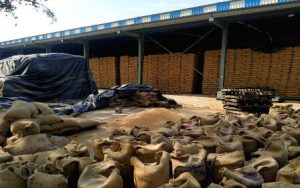Is Our Country Providing ‘Nutritious Food for All’?
India accounts for 195.9 million malnourished people while the Food Corporation of India granaries is overflowing.

Our government has taken upon the challenge to make India malnutrition-free by 2022.In times where India now accounts for one-third of the world’s malnourished and with an estimated of 19 crore people (nearly 14 per cent of our national population) forced to sleep on an empty stomach, the inevitable questions remains whether our efforts as a nation to end malnutrition are enough?
In a landmark judgement, the Supreme Court in the case of People’s Union Civil Liberties of India v. Union of India &Ors. held ‘Right to Food’ as a fundamental right under Article 21 of the Constitution. As per research studies and reports at both international and national levels, it is in fact malnutrition which is deemed as one of the most prominent silent killer plaguing our nation.
Also Read : Pds System One Nation One Ration Card And Beyond
The government in their endeavour to eradicate hunger and malnutrition is running various schemes such as The Public Distribution System, Antyodaya Anna Yojana, The National Programme of Nutritional Support to Primary Education, also known as ‘Mid-Day Meal Scheme’, Integrated Child Development Services, Annapurna Scheme; The National Old Age Pension Scheme, The National Maternity Benefit Scheme and The National Family Benefit Scheme (NFBS), Poshan Abhiyaan Yojna to name a few. Further, the Parliament of India on 10 September 2013 enacted the National Food Security Act, 2013 causing a paradigm shift in the approach food security from welfare to a rights-based approach. Hence, both the State and Central governments in the country have launched a range of promotional, preventive and protective social measures to tackle deprivation, food insecurity and poverty alleviation.

Despite, the Annual Budgetary allocation for the Department of Food & Public Distribution, Ministry of Consumer Affairs and Food & Public Distribution for the year has 2016–2017(Actual) been INR 1.15 lakh crore, for 2017–2018 (Revised) has been INR 1.45 lakh crore, for 2018–2019 has been INR 1.74 lakh crore and for 2019–2020 is INR 1.92 lakh crore for various schemes, including those combating and preventing hunger, malnutrition and starvation. It has been estimated that 4,500 children die every day owing to hunger, while the statistics owing to hunger-related deaths in adults have not been computed. Further, our country ranks 102th out of 117 countries as per the Global Hunger Index, 2019 and ranks 76th out of 113 countries as per the Global Food Security Index, 2018 as India accounts for 195.9 million malnourished people, which is nearly 24 per cent of the world’s malnourished population.
The statistics available stress the need for effective implementation of the existing policies and schemes and newer radical solutions.
Interestingly, it is not plausible that the shortage of food grains in the country which is responsible for the grim scenario since, as per a recent report, with Food Corporation of India granaries overflowing, the government is looking to liquidate its grain stocks to prevent damage and minimize the carrying cost in the country beyond the requirement. In fact, the Food Ministry wants the Ministry of External Affairs to look at the option of presenting the surplus grain stocks as ‘humanitarian aid to deserving countries’.
A group of activists have preferred Public Interest Litigation before the Supreme Court of India with the objective of ‘Food for All’. They demand to establish state-funded or private–public partnership funded community kitchens (using CSR funds) pan-India to combat hunger, malnutrition and starvation and additionally for creation of a national food grid for persons outside the purview of PDS. The Bench of the Supreme Court led by Justice N.V. Ramana and Justice Sanjiv Khanna has favoured setting up of such a scheme given the prevalent state of the nation.
Also Read : Time To Assert Land Rights As Human Rights
The model of state-run or PPP-run community kitchens as proposed by the Petitioners places reliance on the existing state-run community kitchens,wherein cooked nutritious food is provided to persons at subsidized rates in states such as Tamil Nadu(AmmaUnavagam), Rajasthan (Annapurna Rasoi), Karnataka (Indira Canteens), Delhi (Aam Aadmi Canteen), Andhra Pradesh (Anna Canteen), Jharkhand (Mukhyamantri Dal Bhat) and Odisha (Ahaar Centre), Uttarakhand (Indira Amma Canteen), which have been established with the same object of combating hunger and malnutrition crisis in the nation, providing nutritious food at subsidized rates to the lower socio-economic strata of the society. Moreover, these kitchens are solving a dual purpose as personnel employed in these community kitchens facilitate employment, which poses as an added advantage in this economy, where even joblessness is rampantly on the rise, adding to the cycle of hunger and malnutrition.
Though the legislature included a provision for community kitchens in the National Food Security Bill, 2011, the proposed provision has not been included in the National Food Security Act, 2013.
Therefore, in light of the aforementioned facts, it appears that our nation possesses sufficient resources to introduce the proposed kitchens and emphasize on the transition from ‘Right to Food’ to ‘Right to Nutritious Food’ as a fundamental right under Article 21 of the Constitution of India is the need of the hour.
(The writer along with Advocates Fuzail Ahmad Ayyubi and Mandakini Singh has filed the above mentioned Public Interest Litigation on the establishment of Community-Kitchens across the nation).
